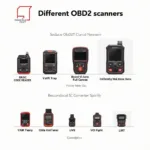The OBD2 code P1316 is a common yet often misunderstood diagnostic trouble code (DTC) related to your vehicle’s ignition system. This code indicates an issue with the Ignition Coil Control Circuit Low, specifically pointing to a problem within the primary or secondary circuit of the ignition coil, or potentially the wiring and connectors associated with it. This article will provide you with a comprehensive understanding of the P1316 code, its causes, symptoms, diagnostic procedures, and potential solutions.
What Does the P1316 Code Mean?
The P1316 code signifies a low voltage condition detected in the ignition coil control circuit. This can disrupt the proper functioning of the ignition system, affecting the engine’s performance and potentially leading to drivability issues. Understanding the underlying causes of this low voltage is crucial for effective diagnosis and repair. This could stem from a faulty ignition coil, damaged wiring, a failing crankshaft position sensor, or even a problem with the powertrain control module (PCM).
Common Causes of the P1316 Code
Several factors can contribute to the P1316 code. Identifying the root cause requires a systematic diagnostic approach. Here are some of the most common culprits:
- Faulty Ignition Coil: A damaged or worn-out ignition coil is often the primary cause of this code. The internal windings can break down, leading to low voltage and misfires.
- Wiring Problems: Damaged, corroded, or loose wiring in the ignition coil circuit can disrupt the voltage supply, triggering the P1316 code.
- Crankshaft Position Sensor: A malfunctioning crankshaft position sensor can provide inaccurate signals to the PCM, affecting ignition timing and potentially causing the P1316 code.
- PCM Issues: While less common, a faulty PCM can also be responsible for the P1316 code. This requires specialized diagnostic equipment and expertise.
Symptoms of the P1316 Code
The symptoms associated with the P1316 code can vary depending on the severity of the underlying issue. Some common indicators include:
- Check Engine Light: The illumination of the check engine light is the most obvious sign of a potential problem, including the P1316 code.
- Engine Misfires: The engine may misfire or run rough due to the inconsistent spark delivery caused by the low voltage in the ignition coil circuit.
- Reduced Power: You might experience a noticeable decrease in engine power and acceleration.
- Poor Fuel Economy: The engine might consume more fuel due to the inefficient combustion caused by the ignition problem.
- Starting Problems: The vehicle may have difficulty starting or may not start at all.
Diagnosing the P1316 Code
Diagnosing the P1316 code requires a methodical approach, utilizing an OBD2 scanner and other diagnostic tools. Here are some steps to follow:
- Retrieve the Code: Connect an OBD2 scanner to the vehicle’s diagnostic port and retrieve the stored trouble codes.
- Inspect Wiring and Connectors: Visually inspect the wiring and connectors in the ignition coil circuit for any signs of damage, corrosion, or looseness.
- Test the Ignition Coil: Use a multimeter to test the resistance of the ignition coil’s primary and secondary windings.
- Check the Crankshaft Position Sensor: Test the crankshaft position sensor using a multimeter or an oscilloscope.
- Inspect the PCM: If all other components check out, a faulty PCM might be the culprit. Consult a qualified technician for further diagnosis and repair.
How to Fix the P1316 Code
The solution for the P1316 code depends on the specific cause. Here are some potential fixes:
- Replace the Ignition Coil: If the ignition coil is faulty, replace it with a new one.
- Repair Wiring: Repair or replace any damaged, corroded, or loose wiring in the ignition coil circuit.
- Replace the Crankshaft Position Sensor: If the crankshaft position sensor is malfunctioning, replace it with a new one.
- Repair or Replace the PCM: If the PCM is faulty, it may need to be repaired or replaced.
“A thorough diagnosis is crucial before replacing any parts,” advises John Miller, a seasoned automotive diagnostician. “Throwing parts at the problem without proper testing can be costly and ineffective.”
Conclusion
The OBD2 code P1316 indicates a problem with the ignition coil control circuit, which can lead to various engine performance issues. By understanding the causes, symptoms, and diagnostic procedures, you can effectively address this issue and restore your vehicle’s smooth operation. Addressing the P1316 code promptly can prevent further damage to your vehicle’s ignition system and ensure optimal engine performance.
FAQ
- What does the P1316 code mean? It indicates a low voltage condition in the ignition coil control circuit.
- What are the common causes of P1316? Faulty ignition coil, wiring problems, crankshaft position sensor issues, or PCM problems.
- What are the symptoms of P1316? Check engine light, misfires, reduced power, poor fuel economy, starting problems.
- How do I diagnose P1316? Use an OBD2 scanner, inspect wiring, test the ignition coil and crankshaft position sensor.
- How do I fix P1316? Replace faulty components like the ignition coil, wiring, crankshaft position sensor, or PCM.
- Can I drive with a P1316 code? It’s not recommended, as it can lead to further damage.
- Is P1316 a serious problem? It can be, and it’s best to address it promptly.
For further assistance, please contact our 24/7 support team via WhatsApp: +1(641)206-8880, or Email: [email protected]. We are here to help!


